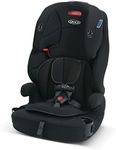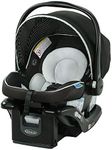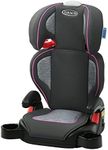Buying Guide for the Best Graco Car Seat
Choosing the right car seat for your child is an important decision that affects both safety and comfort during travel. Car seats are designed to protect children in the event of a crash, but not all seats are the same. It's important to consider your child's age, weight, height, and your vehicle's compatibility when making a choice. Understanding the key features and specifications will help you select a car seat that fits your needs and ensures your child's safety.Type of Car SeatCar seats come in several types: rear-facing, forward-facing, convertible, and booster seats. Rear-facing seats are best for infants and young toddlers because they provide the most protection for a baby's head, neck, and spine. Forward-facing seats are suitable for older toddlers and preschoolers. Convertible seats can switch from rear-facing to forward-facing as your child grows, offering longer usability. Booster seats are for older children who have outgrown forward-facing seats but are not yet big enough for the vehicle's seat belt alone. Choosing the right type depends on your child's age, weight, and height, as well as how long you want the seat to last.
Weight and Height LimitsEach car seat has specific weight and height limits that indicate when it can be used safely. These limits are important because using a seat outside of its recommended range can reduce its effectiveness in protecting your child. When comparing seats, look for those that accommodate your child's current size and allow for growth. For infants, choose a seat with a lower minimum weight, and for older children, look for higher maximum limits to extend the seat's use.
Installation MethodCar seats can be installed using either the vehicle's seat belt or the LATCH system (Lower Anchors and Tethers for Children). The LATCH system is designed to make installation easier and more secure, but not all vehicles or seating positions support it. Some seats are easier to install than others, and proper installation is crucial for safety. Consider your vehicle's compatibility and your comfort with installing the seat. If you plan to move the seat between cars, look for one with clear instructions and user-friendly features.
Adjustability and Ease of UseFeatures like adjustable harness heights, recline positions, and headrests can make a car seat more comfortable and safer as your child grows. Some seats have no-rethread harnesses, which allow you to adjust the harness height without removing the straps. Easy-to-use buckles and clear labeling also help ensure the seat is used correctly every time. If you want a seat that adapts as your child grows or is simple to adjust, prioritize these features.
Safety FeaturesLook for car seats with enhanced safety features such as side-impact protection, energy-absorbing foam, and a sturdy frame. These features provide extra protection in the event of a crash. While all car seats sold must meet minimum safety standards, some offer additional technologies for greater peace of mind. If safety is your top concern, focus on seats with advanced protective features.
Size and Fit in Your VehicleCar seats vary in size and shape, and not all will fit well in every vehicle. Some are bulkier and may not leave enough room for other passengers or car seats. Before choosing, measure your vehicle's back seat and check the car seat's dimensions. If you have a smaller car or need to fit multiple seats, look for more compact models.
Ease of CleaningChildren can be messy, so a car seat with removable and machine-washable covers can make life easier. Some seats have fabrics that are easier to wipe clean or resist stains. If you expect frequent spills or want to keep the seat looking new, consider how easy it is to clean and maintain.










